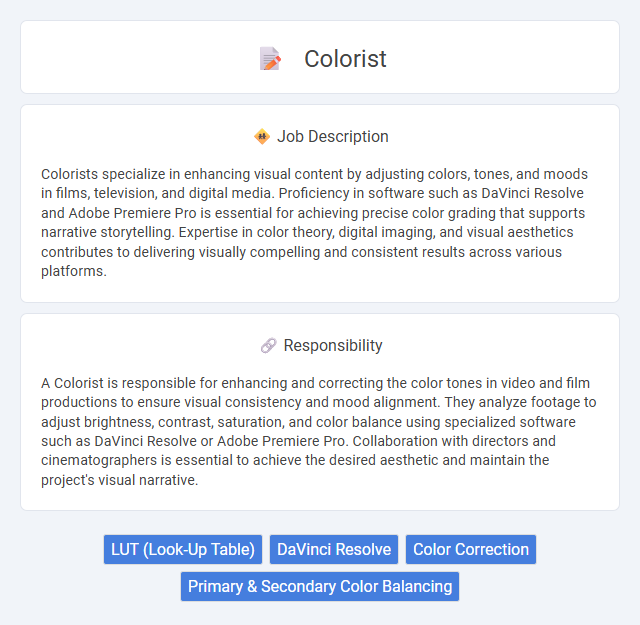
Colorists specialize in enhancing visual content by adjusting colors, tones, and moods in films, television, and digital media. Proficiency in software such as DaVinci Resolve and Adobe Premiere Pro is essential for achieving precise color grading that supports narrative storytelling. Expertise in color theory, digital imaging, and visual aesthetics contributes to delivering visually compelling and consistent results across various platforms.
Individuals with a strong attention to detail and a passion for visual storytelling are likely suitable for a colorist job, as it demands precision in color correction and grading to enhance mood and atmosphere. Those who thrive in collaborative environments and can handle repetitive tasks while maintaining creativity may find this role fitting. Conversely, people who struggle with long hours in front of screens or lack patience for meticulous adjustments might find the position less suitable.
Qualification
A professional colorist must possess advanced skills in color theory, digital imaging software such as DaVinci Resolve and Adobe Premiere Pro, and a keen eye for visual aesthetics. Expertise in film grading, color correction, and understanding of lighting and cinematography principles is essential for producing high-quality visual content. Strong communication and collaboration skills are also necessary to work effectively with directors, cinematographers, and post-production teams.
Responsibility
A Colorist is responsible for enhancing and correcting the color tones in video and film productions to ensure visual consistency and mood alignment. They analyze footage to adjust brightness, contrast, saturation, and color balance using specialized software such as DaVinci Resolve or Adobe Premiere Pro. Collaboration with directors and cinematographers is essential to achieve the desired aesthetic and maintain the project's visual narrative.
Benefit
Working as a colorist likely offers significant creative satisfaction by allowing professionals to enhance the visual tone and mood of films or photographs. The role may provide opportunities for collaboration with directors and cinematographers, contributing to a highly valued project outcome. There is also a probability of gaining experience with cutting-edge color grading software, which could enhance technical skills and career prospects.
Challenge
Colorist jobs likely involve the challenge of accurately balancing hues, contrast, and saturation to create a visually compelling and consistent look across various media. The role probably demands a keen eye for detail and the ability to interpret a director's or client's vision while working under tight deadlines. Mastering advanced software and adapting to evolving color grading technologies could further complicate these challenges.
Career Advancement
Colorists with expertise in digital grading and color correction gain significant career advancement opportunities in film, television, and advertising industries. Mastery of tools like DaVinci Resolve and Adobe Premiere Pro enhances a colorist's ability to work on high-profile projects, leading to roles such as senior colorist, post-production supervisor, or creative director. Continuous skill development and networking within production studios amplify prospects for independent consulting or launching specialized color grading studios.
Key Terms
LUT (Look-Up Table)
A Colorist specializes in enhancing visual storytelling through precise color grading and correction, using LUTs (Look-Up Tables) to apply consistent color profiles across footage. LUTs serve as essential tools for transforming raw video input into stylized, cinematic outputs by mapping input colors to desired output values efficiently. Mastery of LUT creation and application allows Colorists to achieve specific moods, maintain color accuracy, and streamline workflows in post-production environments.
DaVinci Resolve
A Colorist specializing in DaVinci Resolve expertly enhances video footage by manipulating color tones, contrast, and lighting to achieve cinematic quality and visual coherence. Utilizing DaVinci Resolve's advanced tools such as primary and secondary color grading, color wheels, and LUTs, Colorists ensure precise color correction tailored to the director's vision. Mastery of DaVinci Resolve's node-based workflow and HDR grading capabilities is essential for producing professional-grade films, commercials, and digital content.
Color Correction
Colorists specialize in color correction to enhance visual storytelling by adjusting hues, contrast, and brightness to achieve desired aesthetics and mood. They utilize advanced software like DaVinci Resolve and Adobe Premiere Pro to balance color inconsistencies and ensure color grading continuity across scenes. Expertise in color theory, digital imaging, and industry standards is essential for delivering cinematic-quality visuals in film, television, and digital media.
Primary & Secondary Color Balancing
A Colorist specializes in primary and secondary color balancing to enhance the visual tone and mood of video and film projects. Primary color balancing involves adjusting the overall exposure, contrast, and color temperature to establish a consistent foundational look. Secondary color balancing targets specific areas, colors, or objects within the frame to refine details, correct hues, and create stylistic effects that elevate the final output.
 kuljobs.com
kuljobs.com